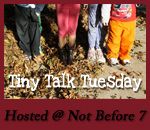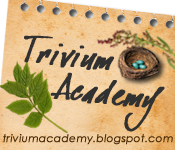 that I would expound upon it a little more for anyone who's thinking about math. I've enjoyed using RightStart Mathematics so much this year and so has Jefferson. I'll start by saying that this is not a comprehensive review of different math programs - I've only used one prior to this one! I've heard great things about Math U See, Saxon, Horizons Math - but I've never used them and won't be comparing them today. Also, if you don't have gallons of time on your hands to read all my blabberings here, just scroll down to the nitty-gritty (in italics) that RS themselves provide about the program.
that I would expound upon it a little more for anyone who's thinking about math. I've enjoyed using RightStart Mathematics so much this year and so has Jefferson. I'll start by saying that this is not a comprehensive review of different math programs - I've only used one prior to this one! I've heard great things about Math U See, Saxon, Horizons Math - but I've never used them and won't be comparing them today. Also, if you don't have gallons of time on your hands to read all my blabberings here, just scroll down to the nitty-gritty (in italics) that RS themselves provide about the program.Last year for Kindergarten, we started Jefferson with Christ Centered Curriculum Math since we were using their phonics program. It was a very good program but I felt bogged down by the character training that was a heavy part of it and often didn't feel enthused about 'doing math.' I struggled to get easy concepts across to Jefferson or to be able to tell if he was understanding me. It came with manipulatives but I often didn't use them since the lessons ran too long with the character training aspects that were tied in.
 So I bravely headed the C.H.A.P. homeschool convention to look for a new program. When I stopped to watch the volunteer at the RightStart table teach onlookers a few lessons, I was hooked! They say that the test of whether you really understand something is how well you can teach it - and I just didn't feel like I was cuttin' it. But as I watched her use the tools and abacus, it seemed sooo clear to me. I thought "If I can see this so clearly than I can teach it."
So I bravely headed the C.H.A.P. homeschool convention to look for a new program. When I stopped to watch the volunteer at the RightStart table teach onlookers a few lessons, I was hooked! They say that the test of whether you really understand something is how well you can teach it - and I just didn't feel like I was cuttin' it. But as I watched her use the tools and abacus, it seemed sooo clear to me. I thought "If I can see this so clearly than I can teach it."So here's the gist - the emphasis is on learning to group numbers in 5's and 10's and learning to visualize this through considerable use of manipulatives (primarily the abacus, as well as cubes, coins, cards, and games). So, rather than counting from 9 up to 13 when asked to add 9 plus 4, RightStart teaches the child to "complete the ten" by taking 1 from the four, giving it to the nine leaving the child with a 'picture' of 10 plus 3 in his head (much easier to add). After practice with the abacus, white board, and card games, this comes quickly to the student.
Also, the student is encouraged to use words to 'narrate back' in words the method they used to come to the answer. This helps the teacher to understand where the student is or isn't understanding a concept. Another "duh" moment for me, as I never used to ask how he figured something out since most of what was taught to him was by memory (ie. 9 plus 4 is 13, 9 plus 5 is 14, yadda, yadda...).
When the student learns to think of numbers in groups of fives and tens, then they can work more easily (and fearlessly, I've found with Jefferson) with larger numbers and this view of numbers becomes important to understanding procedures for doing arithmetic. Students (in the early grades) tend to confuse columns when taught traditionally (stacking numbers and carrying the ones to find the sum), so RS writes the equations horizontally (at first) and develops strength in different strategies (ie. complete the ten) for the student to do it in his head. What I am seeing here with Jefferson is that this builds a good foundation/understanding of what 1's, 10's, 100's really mean.
 Worksheets are not used often since mental warmups and games are the primary source of practice. This is my favorite part of the curriculum! Jefferson will ask all day to play a card game from his math program - and that is what any teacher should want! His confidence is built up thus since the few worksheets that he does do are fairly easy after all the practice he's already done. He was so pleased when he could begin adding his own scores in his head!
Worksheets are not used often since mental warmups and games are the primary source of practice. This is my favorite part of the curriculum! Jefferson will ask all day to play a card game from his math program - and that is what any teacher should want! His confidence is built up thus since the few worksheets that he does do are fairly easy after all the practice he's already done. He was so pleased when he could begin adding his own scores in his head!The following is taken directly from the RS program:
RS General Thoughts on Teaching Mathematics
- Only 5% of mathematics should be learned by rote; 95% should be understood.
- Teaching with understanding depends upon building what the child already knows. Teaching by rote does not care.
- It is easier to understand a new model after you have made one yourself. For example, a child needs to construct graphs before attempting to read readymade graphs.
- Putting thoughts into words helps the learning process.
- "...the root of mathematical study is the creation of mental pictures in the imagination and manipulating those images and relationships using the power of reason and logic." (Mindy Holte)
- Informal mathematics should precede paper and pencil work. Long before a child learns how to add fractions with like denominators, he should be able to add one half and one fourth mentally.
- Refers to quantities of up to 5 as a group; discourages counting individually.
- Uses fingers and tally sticks to show quantities up to 10; teaches quantities 6 to 10 as 5 plus a quantity, for example 6 = 5 + 1.
- Avoids counting procedures for finding sums and remainders. Teaches five- and ten-based strategies for the facts that are both visual and visualizable.
- Employs games, not flashcards, for practice.
- Once quantities 1 to 10 are known, proceeds to 10 as a unit. Uses the "math way" of naming numbers for several months; for example, "1 ten-1" for eleven, "1 ten-2" for twelve, "2-ten" for twenty, and "2-ten 5" for twenty-five.
- Uses expanded notation (overlapping) place-value cards for recording tens and ones; the ones card is placed on the zero of the tens card. Encourages a child to read numbers starting at the left and not backward by starting at the ones column.
- Proceeds rapidly to hundreds and thousands using manipulatives and place-value cards. Provided opportunities for trading between ones and tens, tens and hundreds, and hundreds and thousands with manipuatives.
- Only after the above work, about the fourth month of first grade, introduces the traditional English names for quantities 20 to 99 and then 11 to 19.
- Teaches mental computation. Investigates informal solutions, often through story problems, before learning procedures.
- Teaches four-digit addition on the abacus, letting the child discover the paper and pencil algorithm. This occurs in Level B [1st grade]. Four-digit subtraction is mastered in Level C [2nd grade].
- Introduces fractions with a linear visual model.
- Approaches geometry through drawing boards and tools.
- Teaches short division (where only the answer is written down) for single-digit divisors, before long division. Both are taught in Level E [4th grade].
Sheeeesh! So there it is - my opinion and some info straight from the RS teacher's manual (Level B). Please feel free to ask questions if you want info on our experience or just head to the RS site. So far we plan on continuing through this program with Jefferson. As far as Reagan, we haven't yet decided to go with this or with the Semple Math that was recommended by her evaluator. More research to be done for her.











4 comments:
After reading this, I'm convinced to look into this curriculum. I went to public school, and although the "tens" idea wasn't taught, per se, I have always naturally come up with that idea and that's how I have always worked mentally.
My husband is a calculus teacher and has been very choosy about our math curriculum from day one. He wants our children not to "learn" math but to "think" math. Studies have shown that 4th grade is the peak of math learning for most students. If they haven't been taught how to "think" math by then their skills and confidence quickly go down as they progress through school. Hence the "I hate math" mantra of Jr. High.
We use Singapore and Miquon math and have loved it. Our fifth grader just completed the Miquon series and we'll be on the hunt again for something different.
I really like what you showed us hear. I'm going to pass it his way and see what he thinks. I'm always looking for more visuals and manipulatives.
Thanks for sharing. I always enjoy it.
HEY!! This is what we use! I'm planning on using it again next year too! Cool!!
Thank you so much for your help!!! I just ordered RS B for Will. I'm glad to have that decision and purchase behind me!!! :) THanks again!
Post a Comment